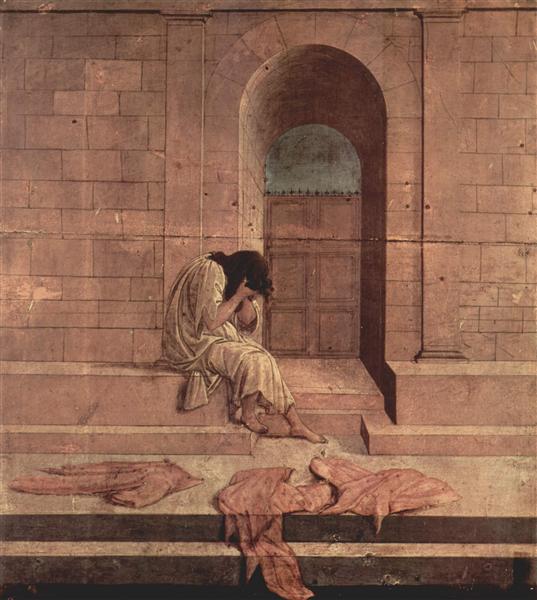Beschreibung
Das Gemälde "El Paria" (1496) von Sandro Botticelli steht als rätselhafte Arbeit in seiner riesigen künstlerischen Produktion, die die Konventionen seiner Zeit in Frage stellt und einen tiefen visuellen Kommentar zu Entfremdung und menschlichem Leiden bietet. Diese Arbeit, die weniger bekannt ist als ihre berühmten Kreationen wie "Die Geburt von Venus" oder "Spring", lädt uns ein, die Komplexität ihrer Themen durch eine Komposition zu erforschen, die sowohl die technischen Fähigkeiten von Botticellis als auch seine tiefe Sensibilität gegenüber dem menschlichen Zustand entfaltet.
In dem Gemälde wird die zentrale Figur eines Mannes, der besorgt und verdrängt zu sein scheint, unter Ausdruck von Unruhe beobachtet. Dieser Charakter, der oft als Paria interpretiert wird, wird in einer Landschaft dargestellt, die, obwohl die charakteristische Schönheit von Botticelli hervorgerufen wurde, auch eine spürbare Isolation widerspiegelt. Die Umgebung besteht aus einem weichen Hintergrund, in dem die Töne von Grün und Braun in der natürlichen Landschaft mit der Farbe der Kleidung des Menschen kontrastieren. Die Palette wird überwiegend in irdischen Tönen mit geringfügigen Abweichungen präsentiert, die auf ein weiches Licht hinweisen, was zu einer Atmosphäre der Melancholie führt.
Die Zusammensetzung von "El Paria" ist faszinierend, da sich die Figur des Ausgestoßenen auf die Leinwand konzentriert, mit einer subtilen Herangehensweise an seinen Körper und sein Gesicht. Botticelli verwendet seinen charakteristischen linearen Stil, der längliche und elegante Formen betont, was der Figur eine fast ätherische Ästhetik verleiht. In dieser Arbeit ist Botticellis Verbindung mit dem Neoplatonismus, in dem Schönheit und Traurigkeit zusammenleben und sich gegenseitig ergänzen, nicht schwer zu bemerken. Das Aussehen des Ausgestoßenen, der auf einen unbestimmten Ort gerichtet ist, bewirkt dem Betrachter ein Gefühl der Empathie, als ob das Gemälde in einem breiteren sozialen Kontext über menschliches Leiden sprechen könnte.
Es ist interessant zu berücksichtigen, dass "Paria" eine Interpretation der Marginalität in der Renaissance -Gesellschaft widerspiegeln könnte. Oft wurde es mit dieser Arbeit mit einem Kontext der Reflexion über den Verlust göttlicher Gnade oder sozialer Verbannung in Verbindung gebracht, sehr relevante Themen während der Zeit, in der Botticelli arbeitete, in denen Religion und Moral zentrale Themen in der Kunst waren. Obwohl es keinen Konsens über die genaue Erzählung hinter dem Werk gibt, wird der Zustand des Ausgestoßenen als Symbol für Leiden und Ausgrenzung dargestellt.
Botticellis Einfluss auf die Kunst der Renaissance ist unbestreitbar, und "El Paria" wird an der Schnittstelle zwischen religiöser Kunst und dem säkularsten Ausdruck menschlicher Gefühle gestellt. Diese weniger anerkannte Arbeit bereichert unser Verständnis der introspektiven Natur des Künstlers sowie seine Fähigkeit, die Komplexität der menschlichen Erfahrung darzustellen. Die Kombination seiner Maltechnik, seiner vernünftig ausgewählten Palette und seines einzigartigen visuellen Ansatzes machen "El Paria" zu einem faszinierenden Ausgangspunkt, um die Entfremdung und Schönheit in der Arbeit eines der größten Lehrer in der Renaissance miteinander verbunden zu machen.
In diesem Sinne dient "Paria" nicht nur als Zeugnis von Botticellis künstlerischem Genie, sondern auch als zeitlose Erinnerung an die menschlichen Kämpfe, die im Laufe der Jahrhunderte mit den Emotionen und Realitäten der Realitäten der Vergangenheit miteinander verbunden sind. Die Arbeit sticht in ihrer Unklarheit auf und lädt den Beobachter ein, über die sozialen Umstände der ausgeschlossenen und Schönheit nachzudenken, die immer noch in ihrem Leiden zu finden sind.
KUADROS ©, eine berühmte Farbe an Ihrer Wand.
Handgemachte Ölgemälde, mit der Qualität professioneller Künstler und dem unverwechselbaren Siegel von KUADROS ©.
Pictures Reproduction Service mit Zufriedenheitsgarantie. Wenn Sie mit der Nachbildung Ihres Gemäldes nicht vollständig zufrieden sind, erstatten wir Ihr Geld zu 100%.

